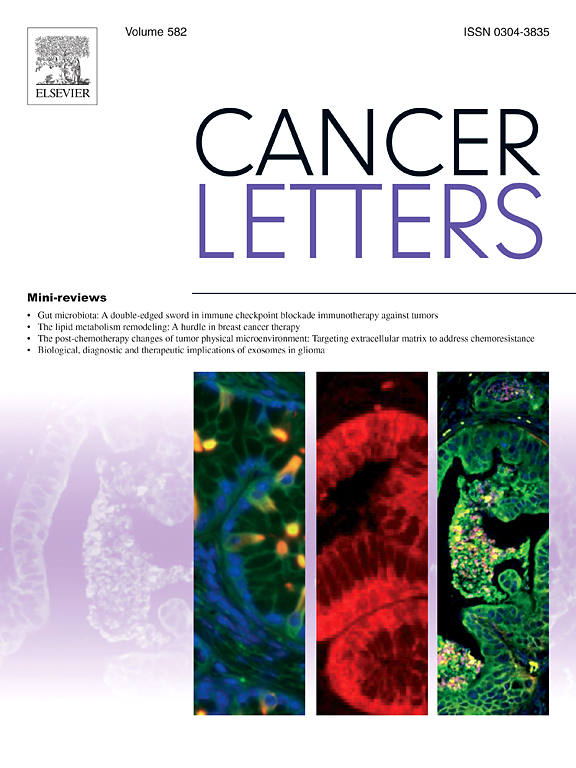WDR11-DT enhances radiosensitivity via promoting PARP1 degradation and homologous recombination deficiency
IF 9.1
1区 医学
Q1 ONCOLOGY
引用次数: 0
Abstract
Radiotherapy is an important management for non-small cell lung cancer (NSCLC). Although long non-coding RNAs (lncRNAs) have been reported to be involved in modulating radiosensitivity, the underlying mechanisms are still largely unclear. Here, we found that tumor suppressor WDR11-DT is a novel radiation-induced lncRNA, which is transcriptionally regulated by SPDEF, in NSCLC. In contrast to normal tissues, WDR11-DT is down-regulated in NSCLC specimens and its low expression was associated with poor prognosis of patient receiving radiotherapy. Importantly, WDR11-DT can markedly enhance NSCLC cells’ radiosensitivity in vitro and in vivo. WDR11-DT functions through distinct mechanisms via binding different proteins. WDR11-DT facilitates interactions between PARP1 and its E3 ligase TRIP12, promotes PARP1 protein degradation and suppresses PARP1-controlled Single-strand breaks (SSBs) repair. Additionally, WDR11-DT binds RNA-bind protein HNRNPK, represses its functions in improving RNA stability of homologous recombination (HR) genes, decreases expression of BRCA1, ATM, BLM and RAD50, and suppresses radiotherapy-triggered HR repair. WDR11-DT-induced dual restraints of PARP1 and the HR pathway lead to the accumulation of double-strand breaks as well as synthetic lethal effects of malignant cells, which, thereby, enhances radiosensitivity and inhibits progression of lung cancer. These results extend our current knowledge of radio-biology and elucidate that WDR11-DT may be a new target for boosting cancer radiotherapy.
WDR11-DT通过促进PARP1降解和同源重组缺陷增强放射敏感性
放疗是治疗非小细胞肺癌(NSCLC)的重要手段。尽管有报道称长链非编码rna (lncRNAs)参与调节辐射敏感性,但其潜在机制仍不清楚。本研究中,我们发现肿瘤抑制因子WDR11-DT是一种在非小细胞肺癌中受SPDEF转录调控的新型辐射诱导lncRNA。与正常组织相比,WDR11-DT在NSCLC标本中表达下调,其低表达与放疗患者预后不良有关。重要的是,WDR11-DT在体外和体内均能显著增强NSCLC细胞的放射敏感性。WDR11-DT通过结合不同的蛋白,通过不同的机制发挥作用。WDR11-DT促进PARP1与其E3连接酶TRIP12之间的相互作用,促进PARP1蛋白降解并抑制PARP1控制的单链断裂(SSBs)修复。此外,WDR11-DT结合RNA结合蛋白HNRNPK,抑制其改善同源重组(HR)基因RNA稳定性的功能,降低BRCA1、ATM、BLM和RAD50的表达,抑制放疗引发的HR修复。wdr11 - dt诱导PARP1和HR通路的双重抑制,导致恶性细胞双链断裂的积累和合成致死效应,从而增强放射敏感性,抑制肺癌的进展。这些结果扩展了我们目前对放射生物学的认识,并阐明了WDR11-DT可能是促进癌症放疗的新靶点。
本文章由计算机程序翻译,如有差异,请以英文原文为准。
求助全文
约1分钟内获得全文
求助全文
来源期刊

Cancer letters
医学-肿瘤学
CiteScore
17.70
自引率
2.10%
发文量
427
审稿时长
15 days
期刊介绍:
Cancer Letters is a reputable international journal that serves as a platform for significant and original contributions in cancer research. The journal welcomes both full-length articles and Mini Reviews in the wide-ranging field of basic and translational oncology. Furthermore, it frequently presents Special Issues that shed light on current and topical areas in cancer research.
Cancer Letters is highly interested in various fundamental aspects that can cater to a diverse readership. These areas include the molecular genetics and cell biology of cancer, radiation biology, molecular pathology, hormones and cancer, viral oncology, metastasis, and chemoprevention. The journal actively focuses on experimental therapeutics, particularly the advancement of targeted therapies for personalized cancer medicine, such as metronomic chemotherapy.
By publishing groundbreaking research and promoting advancements in cancer treatments, Cancer Letters aims to actively contribute to the fight against cancer and the improvement of patient outcomes.
 求助内容:
求助内容: 应助结果提醒方式:
应助结果提醒方式:


